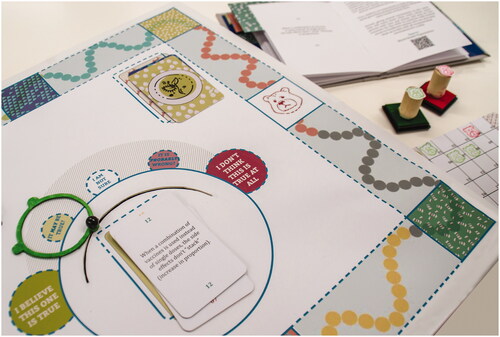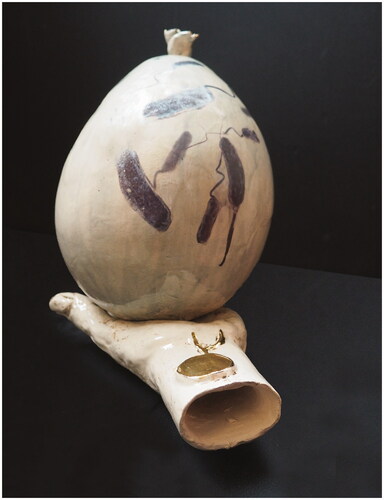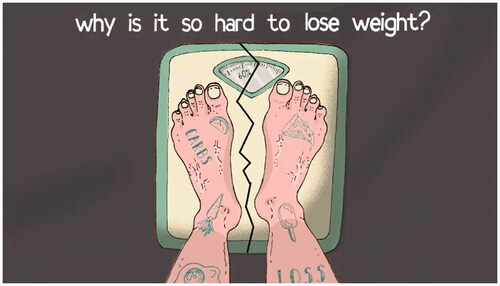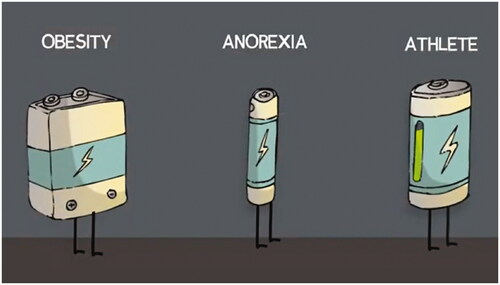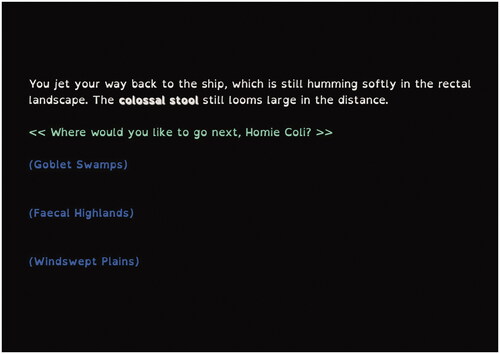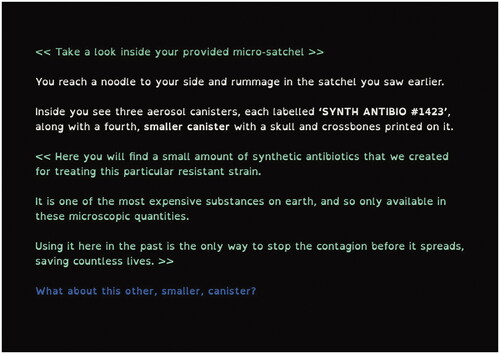Introduction
Established in 2016, the MA Art in Science programme at Liverpool School of Art and Design, Liverpool John Moores University (LJMU), brings artists and scientists together to collaborate across disciplines. The programme cultivates specialist, transferable skills directed towards future vocational opportunities; and facilitates transdisciplinary learning opportunities that are not often available to those singly defined as ‘artists’, ‘scientists’ or ‘researchers’ (Roughley, Smith, & Wilkinson, Citation2019).
The programme’s core values centre on curiosity and experimentation, and students are encouraged to work beyond existing disciplinary boundaries. The programme begins with an introduction to art-science histories and theories, and focuses on engagement with new or existing art-science research through introductory gestures opened up by practical exploration. As the programme progresses, students engage with current debates and issues within contemporary art-science practice. These include matters relating to bioethics, bioart, working with humans in research and public engagement. Students also begin to develop key partnerships with researchers from art and science research centres at LJMU and in the Liverpool City Region, which ultimately guide the design, development and production of a final research project.
These final ‘Major Projects’ are diverse, with topics ranging from an investigation into dark matter through poetry and a dark matter forest installation in a garden shed; to assessing if makeup techniques commonly used by drag artists can help us to avoid facial recognition systems. Amongst other things students have also explored coastal biodiversity by using microscopic diatoms as climate change sensors, and designed 3D printed coral scaffold systems to nurse coral communities back to health.
Since the first year of the programme, a number of students have undertaken practice-based research projects that investigate topics specifically related to anatomy, medicine and public health. The gallery that follows features images and abstracts from final research projects undertaken by students from graduating cohorts between 2016 and 2020, which explore the boundaries of boundaries of art, anatomy, biology, medicine, microbiology and public health.
Figure 1. Photographs from a performance of Dissecting the Future: A Practical Exploration of Speculative Evolution & the Post-human (2017) by Vittorio Manetti.
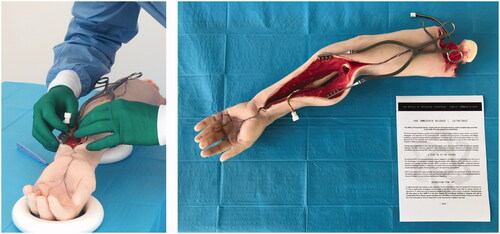
Dissecting the Future: A Practical Exploration of Speculative Evolution & the Post-human
‘Dissecting the Future: A Practical Exploration of Speculative Evolution & the Post-human’ (2017) by Vittorio Manetti () sought to explore the many speculative theories of human evolution in various environments, through a survey of the transhumanism movement and evolutionary biologist’s theories, before disseminating the findings via a staged dissection.
The project aimed to blur the line between science, performance art and reality by attempting to attribute a sense of institutional authority to the dissection of a post-human. This human cannot yet exist but has been created by bringing together some of the more credible speculative theories of humankind’s future evolution and to disseminate them in a tangible way. The project was undertaken with guidance from Professor Partha Vaiude, Director of Surgical-Art UK.
Face and Mask: A Metamorphosis of Pain
Being a sufferer of the neurological condition ‘cluster headaches’, Anthony Pettigrew aimed to survey and analyse the psychology behind our understanding of the face, masks and how they are intrinsically linked. People have and show different masks dependent on which social context we are in at any given time. Chronic pain and its links to emotion and empathy change these masks and this research journey produced masks that portray perceptions of the artist’s pain.
‘Face and Mask: A Metamorphosis of Pain’ (2017) () used 3D scanning, modelling and printing to produce 3D printed representations of faces at differing stages of the pain cycle that could be personalised, printed and used to explain/visualise pain to medical practitioners. The project was undertaken with guidance from Stephen Fairclough, Professor of Psychophysiology at Liverpool John Moores University.
To Donate or Not to Donate? That is the Question!
Conversations surrounding end of life and death can be difficult or taboo for some, meaning that matters of organ and body donation are not widely discussed. ‘To Donate or Not to Donate? That is the Question!’ (2018) by Jessica Irwin () is a comic developed to raise awareness and challenge common misconceptions about donation by encouraging the publics to engage in informed discussions about the different options available. It proposes graphic medicine as an alternative method of presenting donation information to a public audience, and illustrates how the comic medium can communicate body donation information in an accessible and engaging way. ‘To Donate or Not to Donate? That is the Question!’ (2018) was produced with guidance from Sheona Shankland, Anatomy Prosector and PhD Researcher at Lancaster University. Read more about the project here https://doi.org/10.1080/17453054.2020.1770059.
Fata Morgana
Stem cells are undifferentiated cells that can adapt into any cell in the body and are vital for growth and repair. Stem cells may be used to grow personalised human organs for transplantation in the future but this process is still under development. Mixing pig and human DNA to grow human organs in pig ‘incubators’ is one currently available solution to organ shortages.
‘Fata Morgana’ (2018) by Gabrielle York-Salmon () challenges the ethical and moral dilemmas surrounding the growth of human organs in non-human bodies. In collaboration with Claire Stewart, a Professor of Stem Cell Biology at Liverpool John Moores University, this project presents a living non-human incubator growing a beating human heart [silicone sculpture, mechanical pump] to provoke conversations about alternative methods of growing human organs for transplant. Might we find ourselves growing organs in the future to help us live forever? At what point could a transgenic pig be considered a person?
Microbial Mood: Exploring How Sound Affects the Human Microbiome
‘Microbial Mood: Exploring How Sound Affects the Human Microbiome’ (2019) by Sophia Charuhas ( and ) is a research project that aims to inform the publics about recent scientific research concerning the effects of sound on bacterial growth in the human body. The project comprises multiple elements including a prototype bioart experiment and a three-channel video installation, based on research that suggest that bacteria grows differently in response to specific soundwaves, and that sounds can be used to affect the human microbiome via the gut-brain connection.
The bioart experiment, known as the ‘bacteria treatment room’, included agar plates populated with microbiome samples, ‘listening’ to either a recording of an ultrasound bath or the Indian classical song, Raag Kirwani. The three-channel video installation, presented as a ‘human treatment room’, included microscopic and macroscopic images of the artist’s microbiome, set to the same soundtracks used in the bioart experiment. It contrasted low and high frequency sounds for their constructive and destructive effects, respectively, on bacterial growth and activity. Can sounds treat mood disorders by influencing the human microbiome? Could high-frequency noises be used as an alternative to antibiotics if they can successfully kill or inhibit bad bacteria? Could sound therapy be used to heal the gut microbiome?
The project was produced in collaboration with Dr Glyn Hobbs, a Reader in Applied Microbiology at Liverpool John Moores University.
The Choice is Yours: A Vaccination Game
It is a dangerously popular misunderstanding that vaccination is an unnecessary procedure that results in more harm than benefit, if any at all. Historically, this belief is as old as the practice of inoculation itself, but modern means of publicity have turned this practice of misunderstanding into a real threat to public health recognised by global authorities.
As social media allows any voice an opportunity to be heard and go ‘viral’, the vaccine hesitancy spreads. Together with some political, religious, social and psychological factors the anti-vaccination propaganda proves very effective, resulting in the lowering percentage of vaccinated members.
Interactive engagement is a proven effective public health tool, and gamification of topics can motivate people, providing immersive ways to learn and test their knowledge. ‘The Choice is Yours: A Vaccination Game’ (2020) by Inara Tsenina () was designed as an attempt to address communication gaps by creating an educational game that encourages fact-checking.
CERAMIC Transmission
‘CERAMIC Transmission’ (2020) by Helen Birnbaum () looks the histories of the transmission of disease. Electronic sound components are integrated into sculpted ceramic forms that can be activated by touch. Through touch, the sculptures enable greater understanding and interest in theories about disease and transmission. They are also activators of emotions, which are evoked when memorable sounds are heard. These interactions represent the relationship between art and science through connections between ceramic material, sound, touch and vision.
‘Bad Air’ refers to obsolete theory that believed infectious diseases were caused by contaminated air and that a person could become infected when ‘miasmas’ were inhaled and then invaded the body and disturbed its vital functions. The balloon is decorated with Mycobacterium Tuberculosis bacteria and suggestively full of bad air. The accompanying sound, activated by checking the pulse on the wrist, is a wheeze.
Energy Deficit – Why is it so Hard to Lose Weight?
Visual health information is widely disseminated via the internet and social media. Animated infographics and other visual communication formats are becoming recognisably successful in their ability to explain scientific information to the publics, especially to those that have limited or no pre-existing scientific knowledge.
The animation ‘Energy Deficit- Why is it so Hard to Lose Weight?’ (2020) by Evie Holmes () aims to bring attention to research by Dr José Areta, Lecturer in Sports Nutrition and Metabolism at Liverpool John Moores Univeristy, surrounding weight loss, weight gain and physiological responses to concomitant exercise and dietary energy restriction (). The project also investigated the appropriateness of infographic health animations with anthropomorphised characters for learning about such topics.
BACTERIA, THE FUTURE: A time- travelling Twine game to save Hugh-manity
Antimicrobial resistance (AMR) results in drug-resistant infections, and in 30 years, drug-resistant infections no longer treatable by antibiotics may cost 100 trillion US dollars and result in 10 million deaths annually. The World Health Organisation states that improving public awareness of this issue is essential to slowing AMR rates.
‘BACTERIA, THE FUTURE: a time- travelling Twine game to save Hugh-manity’ (2020) by Natasha Niethamer () is an ongoing science communication research project exploring an alternative way to communicate the public health threat of antimicrobial resistance through an online text-based adventure game, with the goal to improve microbial literacy. Play the game here https://nniethamer.itch.io/bacteria-the-future
Acknowledgements
The authors would like to thank all of the programme’s collaborative partners in art and science for their support in delivering the programme and supporting final Major Projects. We would especially like to thank Dr. Kathryn Smith and Professor Caroline Wilkinson for their invaluable support in design and delivery of the programme, and supervision of final Major Projects between 2016 and 2020.
Correction Statement
This article has been republished with minor changes. These changes do not impact the academic content of the article.
Reference
- Roughley, M., Smith, K., & Wilkinson, C. (2019). Investigating new areas of art-science practice-based research with the MA Art in Science programme at Liverpool School of Art and Design. Higher Education Pedagogies, 4, 226–243. doi:https://doi.org/10.1080/23752696.2019.1583072

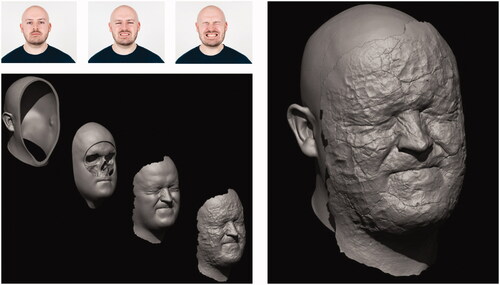
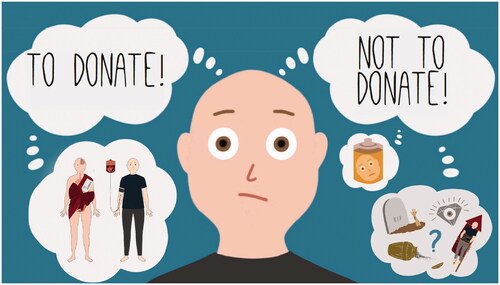
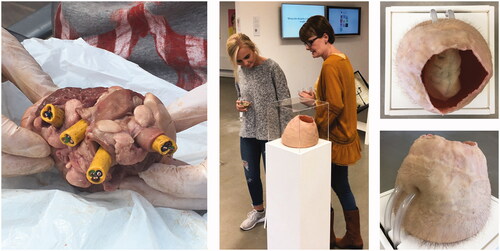
![Figure 5. Photograph from Microbial Mood: Exploring How Sound Affects the Human Microbiome (2019) [bioart experiment] by Sophia Charuhas.](/cms/asset/b31c40fe-f39c-4e32-9f8b-ef2b0c824401/ijau_a_1975495_f0005_c.jpg)
![Figure 6. Photograph from Microbial Mood: Exploring How Sound Affects the Human Microbiome (2019) [three-channel video installation] by Sophia Charuhas.](/cms/asset/570414f2-5104-4a61-ab9f-0c65639f0a42/ijau_a_1975495_f0006_c.jpg)
